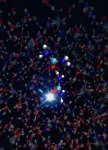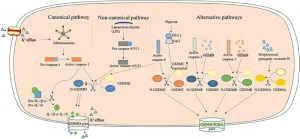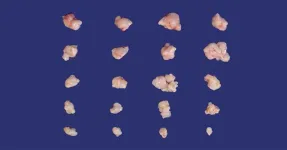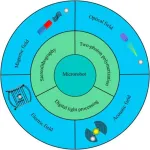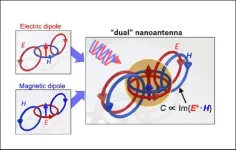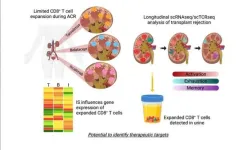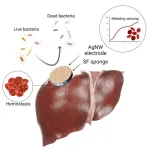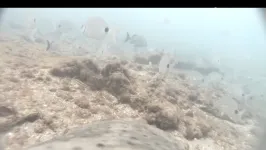(Press-News.org) How did life begin on Earth? Experts have long been fascinated by this question and over the years have come up with a variety of theories. One hypothesis is that the origin of life can be traced back to warm little ponds which are thought to have existed on Earth four billion years ago. The water in these ponds probably contained urea molecules; these were exposed to ultraviolet radiation from the sun, which at that time would have penetrated to the surface of the earth largely unimpeded. This high-energy radiation was able to convert the urea into reaction products which then formed biomolecules that later served as the building blocks of life – or so the idea goes.
This theory of “warm little ponds” was one of the things that led a research team from Hamburg, Zurich and Geneva to devise and carry out a novel experiment. The team led by Hans Jakob Wörner from the Swiss federal institute of technology ETH Zürich and Jean-Pierre Wolf from the University of Geneva used a special X-ray source to examine the first, extremely rapid steps of light-induced urea conversion, as the scientists report in the journal Nature.
For their experiment at the University of Geneva, the team shot pulses of a laser beam through a jet of a highly concentrated urea solution. The laser pulses ionised some of the urea molecules, knocking one electron out of each of them. Immediately afterwards, the scientists sent an ultra-short pulse of soft X-rays behind them. These acted as a probe, revealing in great detail how the urea reacts to the electron being knocked out. The group then repeated the experiment several times, systematically changing the time interval between the ionising laser and the X-ray pulses.
As a result, it was possible to reconstruct the sequence of events precisely – down to a few femtoseconds (quadrillionths of a second). Interpreting the resulting spectra proved to be particularly challenging. “This required detailed computer simulations which we developed here at DESY over many years,” explains DESY physicist Ludger Inhester, who works at the Center for Free-Electron Laser Science, a joint venture of DESY, the University of Hamburg an the Max Planck Society.
The scientists used this setup to work out the initial steps in the conversion of urea. When a urea molecule is ionised, it loses an electron and becomes positively charged. It would like nothing better than to get rid of this positive charge, and that becomes possible when another, non-ionised urea molecule is in the immediate vicinity. “The first molecule then pushes a proton, which is a hydrogen nucleus, over to the neutral molecule,” says Inhester, who also works in the framework of the Cluster of Excellence CUI: Advanced Imaging of Matter at the University of Hamburg. “This proton transfer creates an urea radical along with a positively charged urea ion.” Both are chemically reactive and could have led to the formation of RNA molecules billions of years ago – essential building blocks of early life.
The experiment carried out by the scientists not only demonstrates for the first time the rapid “proton transaction” concluded between two urea molecules, but also reveals its duration – the entire process takes just a few hundred femtoseconds.
“What is new about our experiment is that we were able to observe extremely fast processes in a molecule that exists in an aqueous environment,” explains Inhester points out. “Previous experiments have only looked at reactions like this in the gas phase.” The behaviour of molecules suspended in a liquid such as water is particularly relevant to a whole number of questions – especially when it comes to biological processes. Experiments in this type of environment are a challenge not only when it comes to making the measurements, but also in terms of the computations required to interpret the measured data.
In future, the new technique might also reveal the details of what happens when ionising radiation strikes tissue, causing radiation damage – the type of research that the new Centre for Molecular Water Science (CMWS) envisages doing, that is currently being set up in international cooperation on the DESY campus. The researchers are also toying with the idea of conducting similar experiments at a far larger X-ray source, the European XFEL in Hamburg. This X-ray laser, which is more than three kilometres long and in which DESY plays a pivotal role, produces the most powerful X-ray pulses in the world. “That would allow us to study this proton transfer from different angles,” says Inhester – who hopes this will reveal additional details about this very fundamental process.
DESY is one of the world’s leading particle accelerator centres and investigates the structure and function of matter – from the interaction of tiny elementary particles and the behaviour of novel nanomaterials and vital biomolecules to the great mysteries of the universe. The particle accelerators and detectors that DESY develops and builds at its locations in Hamburg and Zeuthen are unique research tools. They generate the most intense X-ray radiation in the world, accelerate particles to record energies and open up new windows onto the universe. DESY is a member of the Helmholtz Association, Germany’s largest scientific association, and receives its funding from the German Federal Ministry of Education and Research (BMBF) (90 per cent) and the German federal states of Hamburg and Brandenburg (10 per cent).
Reference
Femtosecond Proton Transfer in Urea Solutions Probed by X-ray Spectroscopy; Zhong Yin, Yi–Ping Chang, Tadas Balčiūnas, Yashoj Shakya, Aleksa Djorovic, Geoffrey Gaulier, Giuseppe Fazio, Robin Santra, Ludger Inhester, Jean–Pierre Wolf and Hans Jakob Wörner; „Nature“, 2023; DOI: 10.1038/s41586-023-06182-6
END
High-speed proton transaction
New experiment reveals how ultrafast conversion of urea progresses
2023-06-28
ELSE PRESS RELEASES FROM THIS DATE:
The complex role of pyroptosis in lung cancer: a Chinese Medical Journal Pulmonary and Critical Care Medicine Review
2023-06-28
Lung cancer, one of the most aggressive forms of cancer, continues to be a leading cause of death worldwide. Although several new therapies have been developed for this disease, it has a poor prognosis in its advanced stages. A primary reason underlying this poor response to treatment is the formation of a tumor microenvironment (TME)— the environment that surrounds a tumor and plays a crucial role in its growth. To develop approaches that can overcome treatment resistance during the advanced stages of this cancer, we need to understand ...
The American Association for Anatomy calls for ethical treatment and justice for human body donors
2023-06-28
ROCKVILLE, MD—JUNE 15, 2023 – In response to the allegations of illicit buying and selling of stolen body parts from Harvard Medical School's body donation program, the American Association for Anatomy (AAA) stands united in strong condemnation of the commercialization of human body donors and any action that violates donor ethics and trust. Our heartfelt support goes out to the affected families.
Any act that violates the principles of respect and dignity owed to every individual, in life or death, undermines the sanctity of ...
Scientists design a nanoparticle that may improve mRNA cancer vaccines
2023-06-28
FOR IMMEDIATE RELEASE
Johns Hopkins Medicine scientists say they have developed a nanoparticle — an extremely tiny biodegradable container — that has the potential to improve the delivery of messenger ribonucleic acid (mRNA)-based vaccines for infectious diseases such as COVID-19, and vaccines for treating non-infectious diseases including cancer.
Results of tests in mice, reported June 20 in the Proceedings of the National Academy of Sciences, show that the degradable, polymer-based nanoparticle carrying an mRNA-based vaccine, when injected into the ...
Undergrad-driven project reveals drought’s effects on painted turtles
2023-06-28
A projected rise in droughts could muddy the waters for painted turtles and some fellow freshwater-dwelling reptiles, says 11 years of data collected by 50-plus undergraduates from the University of Nebraska–Lincoln.
Two recent studies based on the data suggest that drought can lower the survival odds, slow the growth and even skew the ratio of female-to-male painted turtles inhabiting the ponds of the Cornhusker State. Those outcomes emerged despite the water level of a sampled pond in southwestern Nebraska remaining relatively steady throughout the observed periods ...
One-two punch: Novel drug pairing could beat pancreatic cancer
2023-06-28
Mutations in the KRAS gene are the major driver of pancreatic cancer. The resulting protein controls multiple signaling pathways involved in cell growth and survival. In cancer, the gene is mutated to be permanently “on,” driving cells to excessively multiply and form tumors.
New drugs have recently been developed to inhibit KRAS and appear to be therapeutically promising. However, pancreatic cancer is especially prone to drug resistance. Most drugs only work for a short period of time before the cancer finds its way around them.
Previous experiments revealed a potential reason why: a group ...
Field-controlled microrobots fabricated by photopolymerization
2023-06-28
A review paper by scientists at the Beijing Institute of Technology summarized the recent research on field-controlled microrobots fabricated by photopolymerization.
The new review paper, published on Jun. 6 in the journal Cyborg and Bionic Systems, provided an overview the photopolymerization technologies utilized in the fabrication of field-controlled microrobots and introduced the photopolymerized microrobots actuated by different field forces and their functions.
“Field-controlled microrobots have attracted extensive research in the ...
Developing a nano-antenna that forms a near field of circularly polarized light: Promising applications in highly sensitive sensing and asymmetric photochemical reactions for molecular chirality
2023-06-28
Main Points
The research group proposed and tested a nano-antenna that uses the specific optical resonance of dielectric nanoparticles to form a near field of circularly polarized light.
This technique bolsters the circularly polarized light-selective response of chiral molecules.
The results of this study should provide applications in chirality analysis and asymmetric photochemical reactions for biomolecules, chemical substances, and pharmaceuticals.
Research Background
“Chirality” refers to the property of a substance that cannot be superimposed on its mirror image. Since the mirror image isomers of chiral molecules ...
Research reveals novel insights into transplant rejection and new drug development targets
2023-06-28
CINCINNATI -- Imagine a day when a urine test could inform a doctor precisely why a kidney transplant patient was experiencing organ rejection and suggest the best medication for specifically addressing the problem.
That day took a leap closer to reality thanks to a remarkable set of single-cell analyses that have identified the most specific cellular signatures to date for kidney transplant rejection. The findings were detailed May 25, 2023, in JCI The Journal of Clinical Investigation.
The study results reflect eight years of teamwork led by experts at Cincinnati Children’s and the University of Cincinnati College of Medicine with contributions ...
All-in-one device for hemorrhage control
2023-06-28
(LOS ANGELES) – June 28, 2023 - A multi-faceted device for effectively treating deep, non-compressible, and irregularly-shaped wounds has been engineered by the scientists at the Terasaki Institute for Biomedical Innovation (TIBI). As outlined in their recent paper in Advanced Science, the device provides rapid hemorrhage management, has minimal inflammatory effects, and provides infection control. It also has tunable biodegradation rates, making it usable for both internal and external use, and features sensing capabilities for long-term hemorrhage monitoring. This versatile device is highly beneficial ...
Boom! Detecting gregarious goliath groupers using their low-frequency pulse sounds
2023-06-28
From growls to pulses to booms, whales, fish and crustaceans all produce sounds. In fact, more than 800 species of fish are capable of making noises for a variety of functions such as courtship and mating, defending their turf or responding to threats. Each of these species has a characteristic waveform that is unique to their “calls.” As such, detecting structures in these signals can be used to identify the sounds of different species.
Classifying sounds produced by fish will help to understand how they respond to environmental changes ...
LAST 30 PRESS RELEASES:
Neuroscientists devise formulas to measure multilingualism
New prostate cancer trial seeks to reduce toxicity without sacrificing efficacy
Geometry shapes life
A CRISPR screen reveals many previously unrecognized genes required for brain development and a new neurodevelopmental disorder
Hot flush treatment has anti-breast cancer activity, study finds
Securing AI systems against growing cybersecurity threats
Longest observation of an active solar region
Why nail-biting, procrastination and other self-sabotaging behaviors are rooted in survival instincts
Regional variations in mechanical properties of porcine leptomeninges
Artificial empathy in therapy and healthcare: advancements in interpersonal interaction technologies
Why some brains switch gears more efficiently than others
UVA’s Jundong Li wins ICDM’S 2025 Tao Li Award for data mining, machine learning
UVA’s low-power, high-performance computer power player Mircea Stan earns National Academy of Inventors fellowship
Not playing by the rules: USU researcher explores filamentous algae dynamics in rivers
Do our body clocks influence our risk of dementia?
Anthropologists offer new evidence of bipedalism in long-debated fossil discovery
Safer receipt paper from wood
Dosage-sensitive genes suggest no whole-genome duplications in ancestral angiosperm
First ancient human herpesvirus genomes document their deep history with humans
Why Some Bacteria Survive Antibiotics and How to Stop Them - New study reveals that bacteria can survive antibiotic treatment through two fundamentally different “shutdown modes”
UCLA study links scar healing to dangerous placenta condition
CHANGE-seq-BE finds off-target changes in the genome from base editors
The Journal of Nuclear Medicine Ahead-of-Print Tip Sheet: January 2, 2026
Delayed or absent first dose of measles, mumps, and rubella vaccination
Trends in US preterm birth rates by household income and race and ethnicity
Study identifies potential biomarker linked to progression and brain inflammation in multiple sclerosis
Many mothers in Norway do not show up for postnatal check-ups
Researchers want to find out why quick clay is so unstable
Superradiant spins show teamwork at the quantum scale
Cleveland Clinic Research links tumor bacteria to immunotherapy resistance in head and neck cancer
[Press-News.org] High-speed proton transactionNew experiment reveals how ultrafast conversion of urea progresses
